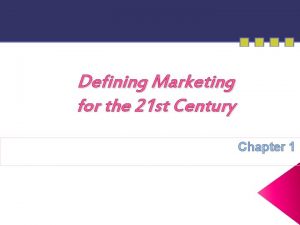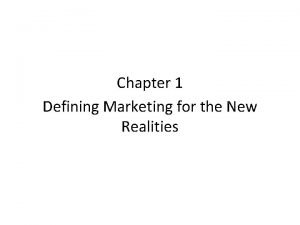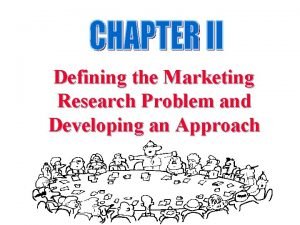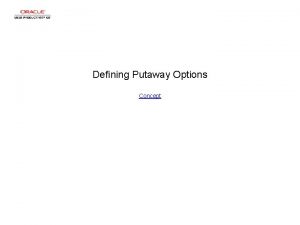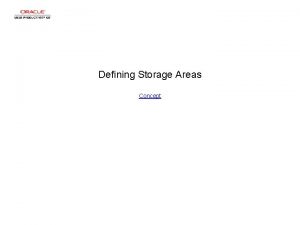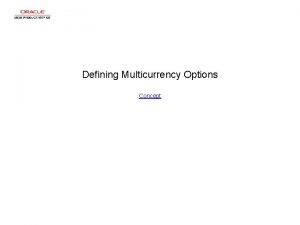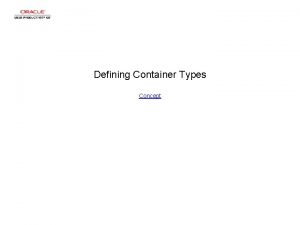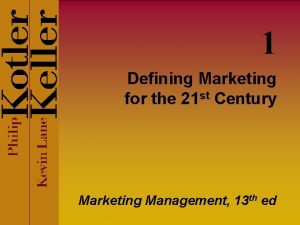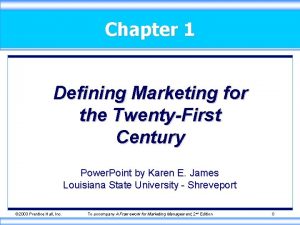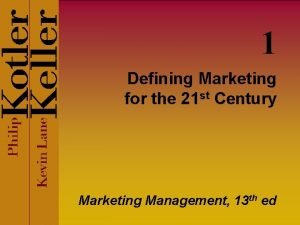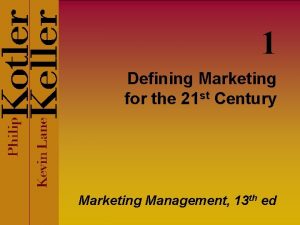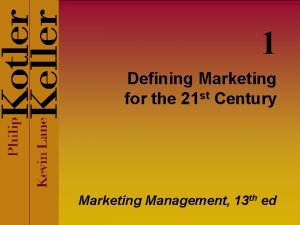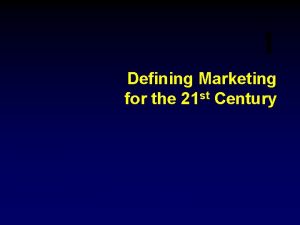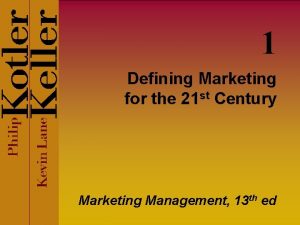Defining Marketing for the 21 st century Instructor





















- Slides: 21

Defining Marketing for the 21 st century Instructor: Omid (Hassan) Samarian Teacher: Dr. Ahmad Zadeh

What is marketing? �simply put: Marketing is the delivery of customer satisfaction at a profit. �Marketing is a social and managerial process whereby individuals and groups obtain what they need and want through creating and exchanging products and value with others.

Marketing importance and role

Core concepts of Marketing �Needs, wants, demands �Products, services, and experiences �Value, satisfaction, and quality �Exchange, transaction, and relationships �Markets

Needs, wants, and Demands �Human needs are states of felt deprivation. They are basic human requirements. These needs were not invented by marketers; they are a basic part of the human makeup. �Wants are the form human needs take as they are shaped by culture and individual personality. Wants are shaped by one’s society. �Demands: human wants that are backed by buying power.

Products, services, and experiences �A product is anything that can be offered to a market to satisfy a need or want. It includes physical objects, services, persons, places, organizations, and ideas. �Thus the term product includes more than just the physical properties of a good or service. It also includes a brand’s meaning to consumers. �The term product also includes more than just goods or services. Consumers decide which events to experience, which entertainers to watch on TV, which places to visit on vacation, which organizations to support through contributions, and which ideas to adopt. To the consumer, these are all products. �Service: an activity or benefit that one party can offer to another that is essentially intangible, and does not result in the ownership of anything.

Value, satisfaction, and quality � Customer value: is the difference between the values the customer gains from owning and using a product and the costs of obtaining the product. Customers often do not judge product values and costs accurately or objectively. They act on perceived value. � Value proposition: a set of benefits to satisfy needs Value = Benefits / Costs = (functional benefits + emotional benefits) / � (monetary costs + time costs + energy costs + psychic costs) Customer satisfaction: depends on a product’s perceived performance in delivering value relative to a buyer’s expectations. If the product’s performance falls short of the customer’s expectations, the buyer is dissatisfied. If performance matches expectations, the buyer is satisfied. If performance exceeds expectations, the buyer is delighted. � Note: a company can always increase customer satisfaction by lowering its price or increasing its services, but this may result in lower profits. Thus, the purpose of marketing is to generate customer value profitably. This requires a very delicate balance: the marketer must continue to generate more customer value and satisfaction but not “give away the house”. � In the narrowest sense, Quality can be defined as “freedom from defects”. � Marketers have two major responsibilities in a quality-centered company. � first, they must participate in forming strategies that will help the company with through total quality excellence. � Second, marketers must deliver marketing quality as well as production quality.

Exchange, transaction, and relationships �Exchange: the act of obtaining a desired object from someone by offering something in term. �Transaction: a trade between two parties that involves at least two things of value, agreed upon conditions, a time of agreement, and a place of agreement. �Relationship marketing: the process of creating, maintaining, and enhancing strong, value-laden relationships with customers and other stakeholders.

Marketing and exchange �Marketing (Kotler, 1980): human activity directed as satisfying needs and wants through exchange processes. �Exchange is the core concept of marketing �Exchange is a value creating process because it leaves both parties better off. �There at least two parties. �Each party has something that might be of value to the other party. �Each party is capable of communication and delivery. �Each party believe it is appropriate or desirable to deal with the other party. �The focal point in an exchange is marketing offer combination of products, services, information, or experience that satisfy a need or want.

Markets �Economists describe a market as a collection of buyers and sellers who transact over a particular product or product class. �Marketers often use the term market to cover various grouping of customers. �Market: the set of all actual and potential buyers of a product or service.

Key customer markets

What is marketed?

Marketing management �Marketing management: �is the analysis, planning, implementation, and control of programs designed to create, build, and maintain beneficial exchanges with target buyers for the purpose of achieving organizational objectives. �Marketing management is concerned not only with finding and increasing demand but also with changing or even reducing it. (Demand management) �Demarketing: marketing to reduce demand temporarily or permanently- the aim is not to destroy demand but only to reduce or shift it.

Marketing management: the newest definition �Marketing management is the art and science �of choosing target markets, and getting, keeping, and growing customers through creating, delivering, and communicating �Superior customer value.

Marketing management practice �In fact, marketing practice often passes through three stages: � 1. Entrepreneurial marketing: most companies are �Started by individuals who live by their wits. They visualize an opportunity and knock on every door to gain attention. � 2. Formulated marketing: as small companies achieve success, they inevitably move toward more formulated marketing. � 3. Entrepreneurial marketing: many large and mature companies need to reestablish within their companies the entrepreneurial spirit and actions that made them successful in the first place. They need to encourage more initiative and “Entrepreneurial” at the local level.

Marketing management tasks �Developing marketing strategies �Delivering value �Capturing marketing insights �Building strong brands �Connecting with customers �Communicating value �Creating long-term growth �Shaping market offerings

Marketing management philosophies

Production and product orientation �Production orientation: �It holds that consumers will prefer products that are very cheap and widely available. �High volume, production efficiency, basic features, mass distribution. �Product orientation: �It holds that consumers will favor those products that offer the most quality, performance or innovative features. �Making superior products and improve it.

Selling concept �It holds that consumers will ordinary not buy enough of the organization’s product. �The Company should undertake aggressive selling and promotion efforts. �Sell more stuff to more people more often for more money in order to make more profit. �The aim is to sell what we make rather than making what market wants.

Marketing orientation �Instead of product or selling, it focuses on customers. �Instead of hunting, marketing is gardening �The job is not to find the right product for your customers. �Being more effective than competitors in creating, delivering and communication superior customer value to the target market.

Thank You For Your Patience & Attention
 Defining marketing for the 21st century
Defining marketing for the 21st century Relative pronouns defining and non-defining
Relative pronouns defining and non-defining Relative clauses defining and non defining
Relative clauses defining and non defining Non defining
Non defining Defining and non defining relative clauses in telugu
Defining and non defining relative clauses in telugu Tipos de relative clauses
Tipos de relative clauses Defining vs non defining relative clauses
Defining vs non defining relative clauses New marketing realities in marketing management
New marketing realities in marketing management Marketing management kotler and keller
Marketing management kotler and keller Defining the marketing research problem
Defining the marketing research problem Participante novato
Participante novato Tcole instructor course
Tcole instructor course Basic instructor course texas
Basic instructor course texas Basic instructor course texas
Basic instructor course texas Pepperball training manual
Pepperball training manual Neither of my two suitcases are adequate for this trip
Neither of my two suitcases are adequate for this trip Instructor vs teacher
Instructor vs teacher Cisco certified trainer
Cisco certified trainer Mptc firearms instructor manual
Mptc firearms instructor manual Basic instructor course texas
Basic instructor course texas Basic instructor course #1014
Basic instructor course #1014 Virtual instructor.com
Virtual instructor.com
